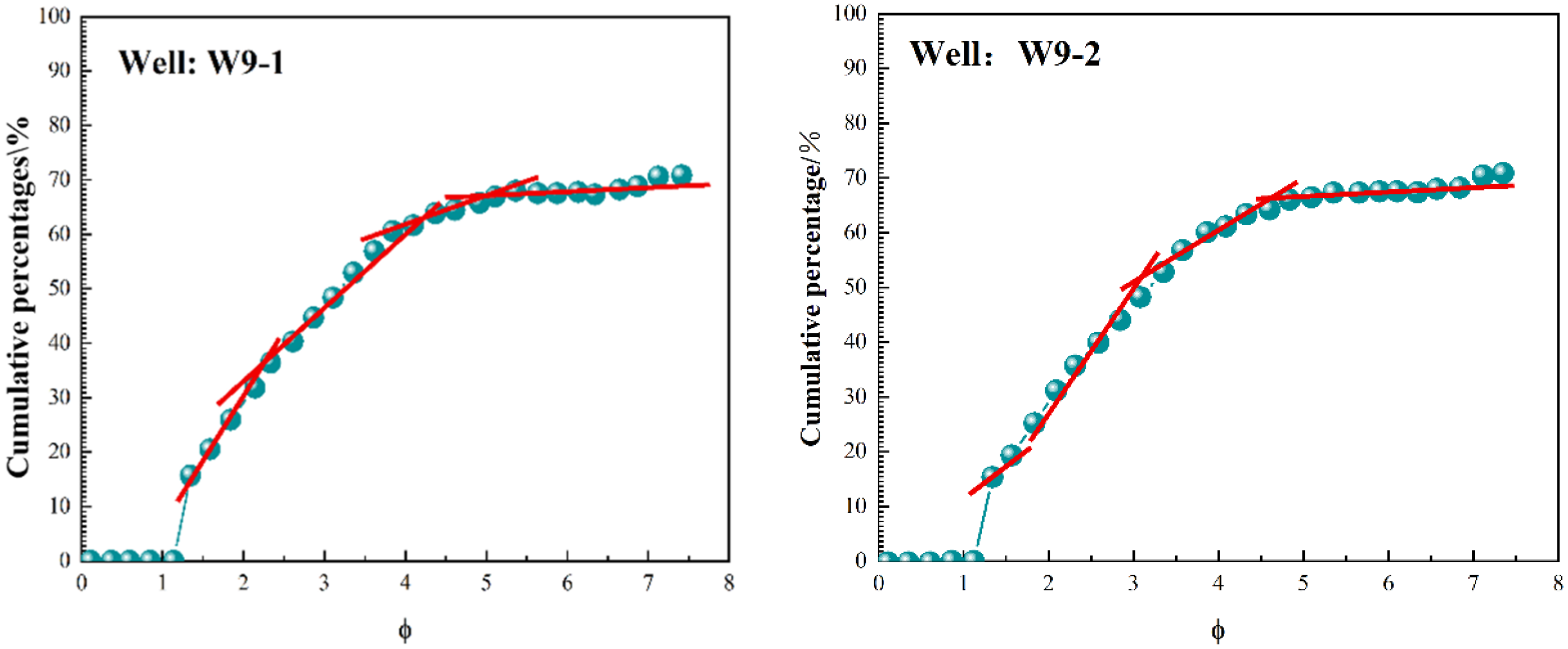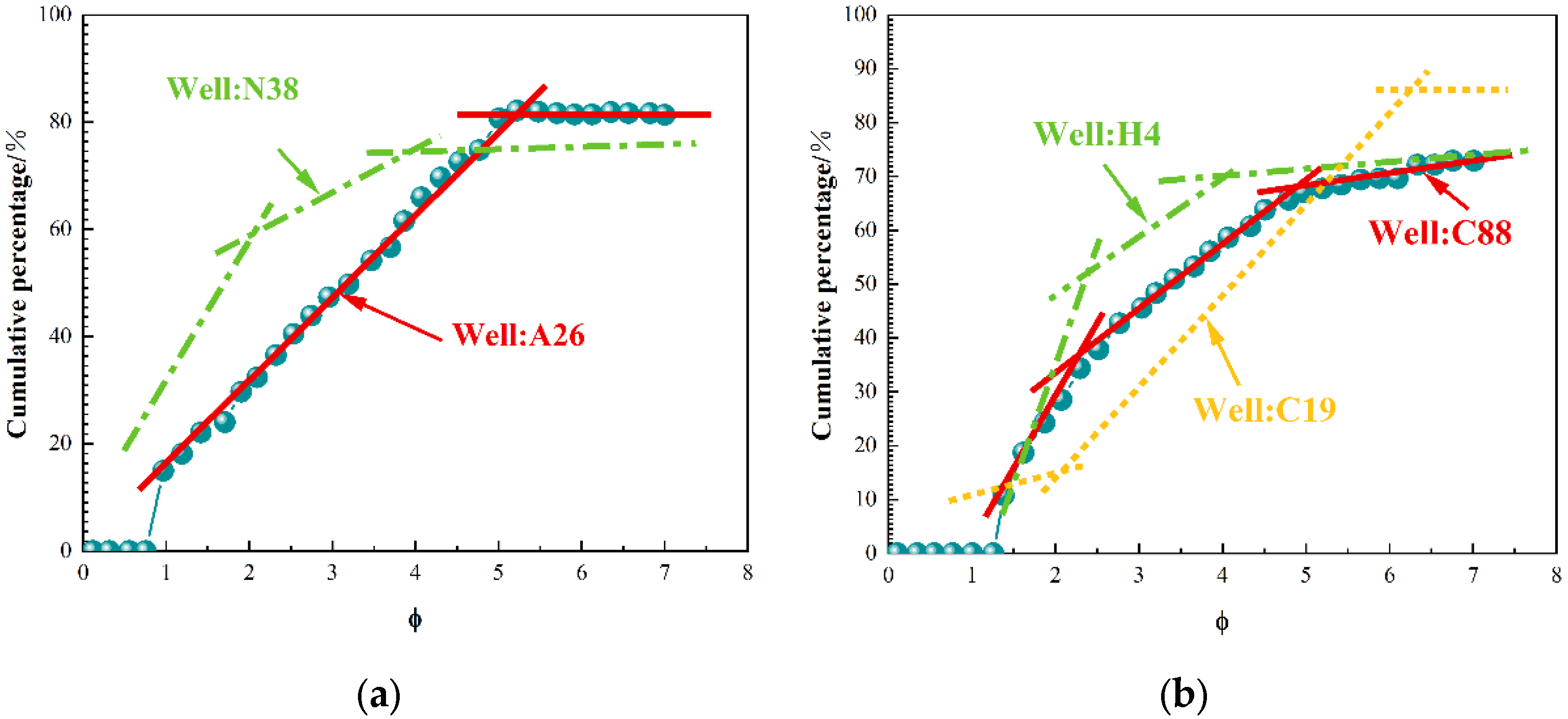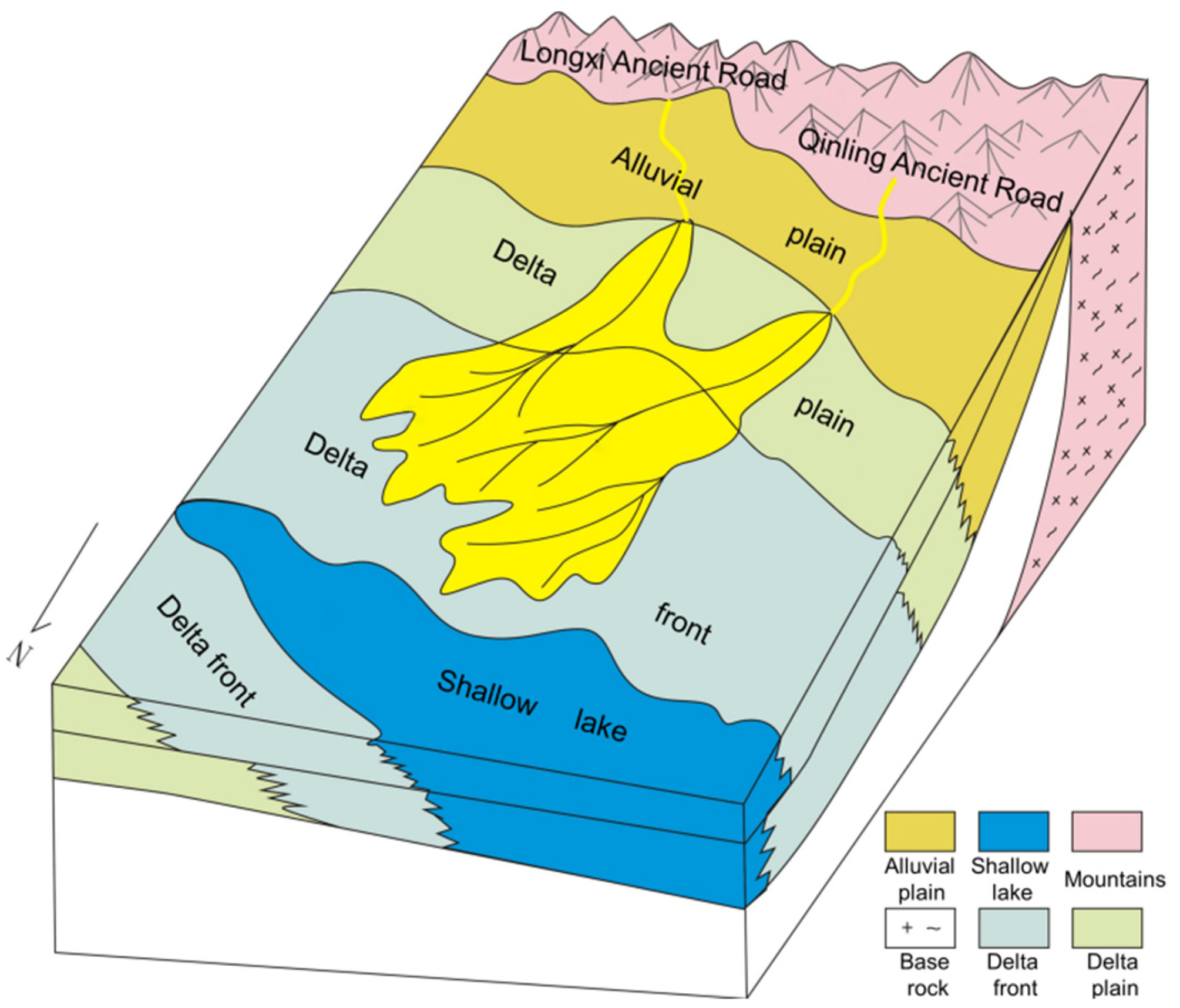Evaluation of Sedimentary Characteristics of the Chang 9 Oil Layer Formation in the Yanchang Formation, Ordos Basin
Abstract
:1. Introduction
2. Research Materials and Methods
2.1. Research Materials
2.2. Research Methods
- (1)
- Scanning electron microscope experimental analysis: It was performed mainly to obtain the micromorphology of core samples by electron signal imaging. SEM experimental analysis involves using a scanning electron microscope (SEM) to examine core samples. The process includes several key steps: preparing samples to ensure they have smooth and conductive surfaces; loading them onto the SEM stage; directing an electron beam onto the sample surface; collecting signals using detectors; processing the signals to enhance image clarity; and analyzing the images to identify microstructural features such as particle size, shape and arrangement. This method facilitates the acquisition of crucial information regarding sample composition, structure and porosity properties through quantitative or qualitative evaluations.
- (2)
- X-ray diffraction experimental analysis: This experiment aimed to utilize X-ray diffraction to analyze the mineral content of rock samples. Initially, the samples undergo meticulous preparation before being loaded into the instrument. Subsequently, X-rays are used to irradiate the samples, and the resulting diffraction patterns are recorded and analyzed for peak positions and intensities. Analysis of peak positions allows inference of each sample’s crystal structure. Moreover, peak intensity correlates positively with mineral content, enabling quantitative analysis of different minerals’ content in the sample. Ultimately, thorough analysis of the diffraction patterns and interpretation of quantitative data yield precise estimations of mineral content in the samples, facilitating in-depth discussions regarding their geological significance.
- (3)
- Rock casting thin section analysis: Rock thin section casting analysis involves several key steps. Firstly, thin sections are meticulously prepared from rock samples and then meticulously imaged under an electron microscope. The electron signals emitted from each sample’s surface are meticulously recorded and thoroughly processed to extract detailed information regarding its microstructure and chemical composition. Subsequently, these thoroughly processed signals undergo meticulous morphological and compositional analysis to accurately identify the rock type. This is followed by a careful comparative analysis with other samples to precisely delineate their differences and characteristics. Through meticulous signal processing via electron beam spots, the rock type of the Yanchang Formation reservoir in Ordos could be precisely determined, facilitating in-depth comparison and analysis of the characteristics of tight oil reservoirs.
3. Results and Discussion
3.1. Regional Geological Background
3.2. Evaluation of Basic Characteristics of Tight Reservoir
3.2.1. Reservoir Space Characteristics
3.2.2. Reservoir Porosity and Permeability Characteristics
3.2.3. Maturity Characteristics of Reservoir Sand Body
3.2.4. Grain Size Characteristics of Reservoir Sand Bodies
3.3. Plane Distribution Characteristics of Sedimentary Facies in the Study Area
3.4. Vertical Structural Characteristics of Sand Body in the Study Area
3.5. Sedimentary Model
4. Conclusions
- (1)
- In the study area, the reservoir porosity of the Chang 9 oil layer formation is between 3 and 12%, and the permeability is between 0 and 1.5 × 10−3 μm2, classifying it as an ultra-low-porosity and ultra-low-permeability reservoir; Chang 9 sandstone is composed of feldspar sandstone and lithic feldspar sandstone. Among them, the average content of quartz is low, at less than 31%; the average content of feldspar is high, amounting to more than 34%; and the average content of rock debris is distributed between 10% and 20%. Therefore, the compositional maturity of the Chang 9 sand body is generally low. The particle size parameters and particle size distribution are complex and changeable, and the particle size distribution shows positive skewness, indicating that the sediments in the sand body are mainly coarse components; the kurtosis of the particle size frequency curve is flat to very sharp.
- (2)
- By analyzing the plane distribution characteristics of sedimentary facies in the Chang 91 period of the Chang 9 oil layer formation in the Ordos Basin, it has been determined that the sedimentary pattern of the Chang 91 period basically inherited the distribution characteristics of sedimentary facies of the Chang 92 period. However, due to the basin subsidence and large lake transgression, the lake shoreline moved landward, the lake area expanded, the lake water deepened and a semi deep lake–deep lake facies belt appeared in the southeast part of the basin.
- (3)
- The vertical structure of the sand body of Chang 9 oil layer formation in the Ordos Basin can be roughly summarized as a box-shaped structure with upward thinning, a bell-shaped structure with upward thinning and a funnel-shaped structure with upward thickening. The sedimentary microfacies evolution of the Chang 9 oil layer formation has certain continuity, and the reservoir of the Chang 9 oil layer formation in the Chang 9 period belongs to the slow rising period of the lake basin. In the early stage of Chang 9, the lake basin rose, the shallow lake area became larger and the delta area gradually decreased. In the middle to late stage of Chang 9, the delta front area expanded, the source supply was sufficient and the sand body developed well.
Author Contributions
Funding
Institutional Review Board Statement
Informed Consent Statement
Data Availability Statement
Conflicts of Interest
References
- Zou, C.C.; Yang, Z.; Zhang, G.S.; Hou, L.H.; Zhu, R.K.; Tao, S.Z. Theoretical understanding and practical significance of “orderly accumulation” of conventional-unconventional oil and gas. Pet. Explor. Dev. 2014, 41, 3–4. [Google Scholar] [CrossRef]
- Wang, Y.; Liu, L.F.; Li, S.T.; Ji, H.T.; Li, L.Z.; Luo, Z.H. Formation and densification process of Chang 8 oil layer in Triassic Yanchang Formation in western Jiyuan, Ordos Basin. Acta Paleogeogr. 2017, 05, 142–156. [Google Scholar]
- Guo, Q.L.; Wu, N.; Chen, N.S.; Ren, H.J.; Yang, Z.; Xie, H.B. Evaluation of tight oil resources in the seventh oil layer of Yanchang Formation, Ordos Basin. Chin. J. Pet. 2017, 38, 658–665. [Google Scholar]
- Xia, J.S.; Liu, X.H.; Wang, Z.J.; Wen, W.; Tang, X.Y. Sedimentary characteristics of sandy clastic flow in the third member of the Dongying Formation and the first member of the Shahejie Formation in the west of Nanpu Sag, Bohai Bay Basin and its significance for oil and gas exploration. Pet. Acta 2017, 38, 399–413. [Google Scholar]
- Hu, S.Y.; Zhu, R.K.; Wu, S.T.; Bai, B.; Yang, Z.; Cui, J.W. Beneficial exploration and development of continental tight oil in China. Pet. Explor. Dev. 2018, 45, 737–748. [Google Scholar] [CrossRef]
- Potter, P.E.; Pettijohn, F.J. Basin Analysis and the Sedimentary Model. In Paleocurrents and Basin Analysis; Springer: Berlin/Heidelberg, Germany, 1963; pp. 224–251. [Google Scholar]
- Hein, F.J.; Syvitski, J.P. Sedimentary environments and facies in an arctic basin, Itirbilung Fiord, Baffin Island, Canada. Sediment. Geol. 1992, 81, 17–45. [Google Scholar] [CrossRef]
- Neal, A. Ground-penetrating radar and its use in sedimentology: Principles, problems and progress. Earth-Sci. Rev. 2004, 66, 261–330. [Google Scholar] [CrossRef]
- Pemberton, S.G. Trace fossil facies models: Environmental and allostratigraphic significance. In Facies Models: Response to Sea Level Change; Walker, R.G., James, N.P., Eds.; Geological Association of Canada: Ottawa, ON, Canada, 1992; pp. 47–72. [Google Scholar]
- Tao, Y.B.; Ren, T.L.; Huang, Y.B.; Wang, L.J.; Yao, J.J.; Zhang, C.J. Sedimentary geochemical records of paleoenvironmental evolution of the Linjiazhuang-Xingezhuang Formation in the albian stage of Laiyang Basin. Chin. J. Geosci. 2022, 43, 11. [Google Scholar]
- Parrish, J.T.; Soreghan, G.S. Sedimentary geology and the future of paleoclimate studies. Sediment. Rec. 2013, 11, 4–10. [Google Scholar] [CrossRef]
- Ojala, A.E.; Francus, P.; Zolitschka, B.; Besonen, M.; Lamoureux, S.F. Characteristics of sedimentary varve chronologies—A review. Quat. Sci. Rev. 2012, 43, 45–60. [Google Scholar] [CrossRef]
- Delgado-Fernandez, I. A review of the application of the fetch effect to modelling sand supply to coastal foredunes. Aeolian Res. 2010, 2, 61–70. [Google Scholar] [CrossRef]
- Yang, Y.Q.; Qiu, L.W.; Jiang, Z.X.; Yin, X.L. Sedimentary model of lake basins and beach-bars in continental faulted depressions—Taking the upper sub-member of the Paleogene Es4 in Dongying Sag as an example. Chin. J. Pet. 2011, 32, 417–423. [Google Scholar]
- Wu, J.; Jiang, Z.X.; Pan, Y.W.; Zhang, Q.; He, L.Q. Lacustrine fine-grained sedimentary model—Taking the upper sub-member of the fourth member of the Paleogene Shahejie Formation in Dongying Sag as an example. Chin. J. Pet. 2016, 37, 1080–1089. [Google Scholar]
- Jin, J.H.; Cao, Y.C.; Wang, J.; Yang, T.; Zhou, L. Deepwater sandy debris flow deposition: Concept, depositional process and depositional characteristics. Geol. Rev. 2019, 65, 14. [Google Scholar]
- Li, D.H.; Li, J.Z.; Zhang, B.; Yang, J.J.; Wang, S.Y. Formation conditions, resource potential and sweet spot prediction of Jurassic tight oil in Sichuan Basin. Chin. J. Pet. 2017, 38, 740. [Google Scholar]
- Sun, N.L.; Zhong, J.H.; Wang, S.B.; Liu, S.G.; Ni, L.T.; Qu, J.L. Sedimentary characteristics of deep water gravity flow in the Triassic Yanchang Formation in the southern Ordos Basin and its petroleum geological significance. Acta Paleogeogr. 2017, 019, 299–314. [Google Scholar]
- Shen, Y.L.; Guo, Y.H.; Li, Z.F. Sedimentary facies of the Permian Shanxi Formation and the He8 Member of the Lower Shihezi Formation in the Suligemiao Area, Ordos Basin. Acta Paleogeogr. 2006, 8, 53–62. [Google Scholar]
- Xiao, X.G.; Li, Q. Study on reservoir characteristics of Chang 8 oil layer group in Zhiluo Oilfield, Ordos Basin. China Geol. 2014, 41, 187–196. [Google Scholar]
- Gaswirth, S.B.; Marra, K.R.; Cook, T.A.; Charpentier, R.R.; Gautier, D.L.; Higley, D.K.; Whidden, K.J. Assessment of Undiscovered Oil Resources in the Bakken and Three Forks Formations, Williston Basin Province, Montana, North Dakota, and South Dakota, 2013; US Geological Survey Fact Sheet: Liston, VA, USA, 2013. [Google Scholar]
- Smith, M.G.; Bustin, R.M. Production and preservation of organic matter during deposition of the Bakken Formation (Late Devonian and Early Mississippian), Williston Basin. Palaeogeogr. Palaeoclimatol. Palaeoecol. 1998, 142, 185–200. [Google Scholar] [CrossRef]
- Wang, C.; Zeng, Z. Overview of geomechanical properties of Bakken formation in Williston Basin, North Dakota. In Proceedings of the 45th US Rock Mechanics/Geomechanics Symposium, San Francisco, CA, USA, 26–29 June 2011; OnePetro: Richardson, TX, USA, 2011. [Google Scholar]
- Zheng, R.C.; Dai, C.C.; Zhu, R.K.; Zhai, W.L.; Gao, H.C.; Geng, W. Sequence-lithofacies paleogeographical characteristics of Xujiahe Formation in Sichuan-like foreland basin. Geol. Rev. 2009, 4, 484–495. [Google Scholar]
- Wang, Z.; Liu, J.; Jiang, H.; Huang, S.; Wang, K.; Xu, Z.; Jiang, Q.; Shi, S.; Ren, M.; Wang, T. Lithofacies paleogeography and exploration significance of Sinian Doushantuo depositional stage in the middle-upper Yangtze region, Sichuan Basin, SW China. Pet. Explor. Dev. 2019, 46, 41–53. [Google Scholar]
- Zhou, J.; Yao, G.; Yang, G.; Gu, M.; Yao, Q.; Jiang, Q.; Yang, Y. Lithofacies paleogeography and favorable gas exploration zones of Qixia and Maokou Fms in the Sichuan Basin. Nat. Gas Ind. B 2016, 3, 226–233. [Google Scholar] [CrossRef]
- Mingyi, H.; Zhonggui, H.; Guoqi, W.; Wei, Y.; Mancang, L. Sequence lithofacies paleogeography and reservoir potential of the Maokou formation in Sichuan Basin. Pet. Explor. Dev. 2012, 39, 51–61. [Google Scholar]
- Li, Z.; Han, G. Sedimentary facies and paleogeographic evolution of the Yanchang Formation in the Ordos Basin. Geol. J. China Univ. 2019, 25, 29–43. [Google Scholar]
- Wang, J.; Zhang, L.; Wang, D. Sedimentary characteristics and reservoir distribution of the Yanchang Formation in the Ordos Basin. Pet. Explor. Dev. 2020, 47, 145–155. [Google Scholar]
- Gao, W.; Jiang, T.; He, S. Sedimentary facies characteristics and reservoir prediction of the Yanchang Formation in the Ordos Basin. J. Palaeogeogr. 2018, 20, 101–116. [Google Scholar]
- Xiong, J.; Zhang, Y. Comparison of sedimentary characteristics between the Yanchang Formation in the Ordos Basin and other basins. J. Earth Sci. Environ. 2017, 39, 185–193. [Google Scholar]












| Title | Well | Depth (m) |
|---|---|---|
| Cast thin section experiment | W9 | 751.55 |
| H4 | 761.25 | |
| SEM experiment | C19 | 840.47 |
| C88 | 864.77 | |
| X-ray diffraction experiment | Q41 | 875.47 |
| X208 | 793.69 | |
| D38 | 809.43 |
Disclaimer/Publisher’s Note: The statements, opinions and data contained in all publications are solely those of the individual author(s) and contributor(s) and not of MDPI and/or the editor(s). MDPI and/or the editor(s) disclaim responsibility for any injury to people or property resulting from any ideas, methods, instructions or products referred to in the content. |
© 2024 by the authors. Licensee MDPI, Basel, Switzerland. This article is an open access article distributed under the terms and conditions of the Creative Commons Attribution (CC BY) license (https://creativecommons.org/licenses/by/4.0/).
Share and Cite
Qiu, X.; Wang, Y. Evaluation of Sedimentary Characteristics of the Chang 9 Oil Layer Formation in the Yanchang Formation, Ordos Basin. Appl. Sci. 2024, 14, 4035. https://doi.org/10.3390/app14104035
Qiu X, Wang Y. Evaluation of Sedimentary Characteristics of the Chang 9 Oil Layer Formation in the Yanchang Formation, Ordos Basin. Applied Sciences. 2024; 14(10):4035. https://doi.org/10.3390/app14104035
Chicago/Turabian StyleQiu, Xuelin, and Yaning Wang. 2024. "Evaluation of Sedimentary Characteristics of the Chang 9 Oil Layer Formation in the Yanchang Formation, Ordos Basin" Applied Sciences 14, no. 10: 4035. https://doi.org/10.3390/app14104035




